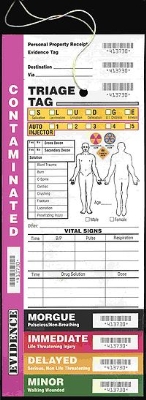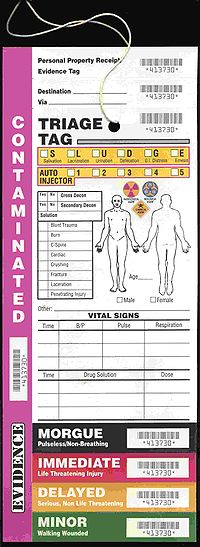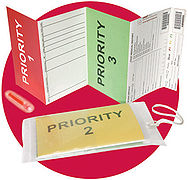
Triage tag
Encyclopedia

Triage
Triage or ) is the process of determining the priority of patients' treatments based on the severity of their condition. This rations patient treatment efficiently when resources are insufficient for all to be treated immediately. The term comes from the French verb trier, meaning to separate,...
tags, the first-arriving personnel are able to effectively and efficiently distribute the limited resources and provide the necessary immediate care for the victims until more help arrives. Triage tags were first introduced by Baron Dominique Jean Larrey
Dominique Jean Larrey
Dominique Jean Larrey was a French surgeon in Napoleon's army and an important innovator in battlefield medicine.-Biography:...
, a French surgeon in Napoleon’s
Napoleon I of France
Napoleon Bonaparte was a French military and political leader during the latter stages of the French Revolution.As Napoleon I, he was Emperor of the French from 1804 to 1815...
army.
Simple Triage and Rapid Treatment (START
Simple triage and rapid treatment
Simple triage and rapid treatment is a method used by first responders to effectively and efficiently evaluate all of the victims during a mass casualty incident . The first-arriving medical personnel will use a triage tool called a triage tag to categorize the victims by the severity of their...
) is a strategy that the first responders and medical personnel employ to evaluate the severity of injury of each victim as quickly as possible and tag the victims in about 30–60 seconds. The triage tags are placed near the head and are used to better separate the victims so that when more help arrives, the patients are easily recognizable for the extra help to ascertain the most dire cases.
Design
A triage tag is two-sided, but the actual layout of the sections vary between and within countries and between governmental agencies. It is now common to use triage tags to allow first responders to have a better handle of the victims during a triage. There is no universal agreement in the design of triage tags, so each authority has implemented their own version to meet their needs.The example Triage Tag shown in this article is the All Risk(R) Triage Tag manufactured by Disaster Management Systems (DMS) located in Pomona, California. This triage tag is manufactured using synthetic paper to enable decontamination. It is the standard tag of several US states including Florida and California. A military version using the terms "EXPECTANT" instead of "MORGUE" and "MINIMAL" rather than "MINOR" is also available. The design of a triage tag could be as simple as the METTAG MT-137, which the military and many governmental agencies use.
Dynamic Triage Tag

Standard Sections Of A Triage Tag
Typically, the basic sections of a triage tag may include:- The four colors of triage and they come in the form of:
- Black (Expectant) which entails pain medication only until death
- Red (Immediate) which entails life threatening injuries
- Yellow (Delayed) which entails non-life threatening injuries
- Green: (Minor) which entails minor injuries
- A section informing medical personnel of the patient’s vital signs along with the treatment administered.
- A section on the patient’s demographics such as gender and residential address, and the patient’s medical history.
- A section with a full pictorial view of the human body. The medical personnel indicate which parts of the body are injured.
Other features may include:
- tear off sections to label the victim properly in terms of severity of injury and to inform other medical personnel, that may arrive later, of the victim’s status.
- main body for the first responders to fill out during their assessment of the patient. This portion will stay with the patient.
- peel off stickers to keep a record of what transportation or treatment was provided to the victim.
Benefits
A benefit in using the triage tag, besides the fact of improving traffic flow and increasing distributed care among injured patients is during the collection of data. The fill-in slots on the triage tags do not need to be filled out all at once. Information can be obtained and added onto the triage tag throughout the triage. There are cases which a patient’s medical condition changes while still in triage, medical personnel would just tag the patient again with the updated information and label the tags sequentially.The other option is to use a tag which can be altered and where the priority can go up or down. This eliminates the need to re-tag the patient.
Examples of types
- The military uses the MT-137 design while Maryland and New Jersey use their customized version.
- The(METTAG Medical Emergency Triage Tags) was developed in the early 1970s and is widely used among the U.S. military, federal, state, and local agencies, and others.
- Another example of a triage tags is the dynamic folding tag Smart Tag from TSG Associates. This was adopted by the State of New York in 2004, the British Military in 2002, used by London Ambulance Service in the 7 July 2005 London bombings7 July 2005 London bombingsThe 7 July 2005 London bombings were a series of co-ordinated suicide attacks in the United Kingdom, targeting civilians using London's public transport system during the morning rush hour....
and used by the combined forces Afghanistan in 2006. An older style dynamic card is the "Cruciform", used in parts of the UK including some of the North Sea oil industry and used by the Royal London Hospital during the London bombings in 2005. - New York, Philadelphia, Boston and Nevada have chosen the Smart Tag with its folded design means that effective triage is quick and simple.
- The States of Connecticut and Massachusetts also mandated the Smart Tag for state wide use.
- Maryland has a more detailed customized design of a triage tag
- New Jersey also has a more detailed customized design
See also
- Emergency Medical TechnicianEmergency medical technicianEmergency Medical Technician or Ambulance Technician are terms used in some countries to denote a healthcare provider of emergency medical services...
- First responders
- Health Insurance Portability and Accountability ActHealth Insurance Portability and Accountability ActThe Health Insurance Portability and Accountability Act of 1996 was enacted by the U.S. Congress and signed by President Bill Clinton in 1996. It was originally sponsored by Sen. Edward Kennedy and Sen. Nancy Kassebaum . Title I of HIPAA protects health insurance coverage for workers and their...
(HIPAA) - MSEHPA
- Client confidentialityClient confidentialityClient confidentiality is the principle that an institution or individual should not reveal information about their clients to a third party without the consent of the client or a clear legal reason...
External links
- http://www.triagetags.com/c-6-all-risk-triage-tags.aspx
- http://www.disastermanagementsystems.com
- http://www.emedicine.com/emerg/topic670.htm
- Smart Tag
- http://www.state.nj.us/health/ems/documents/njdisastertag.pdf
- http://www.miemss.umaryland.edu/MDTriage.pdf

